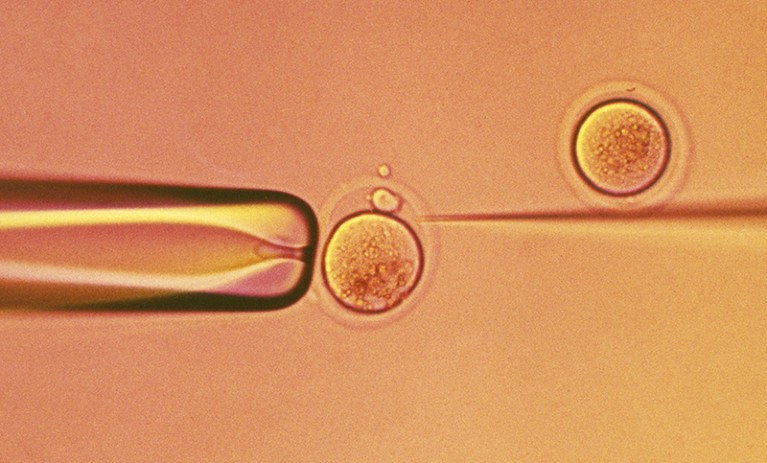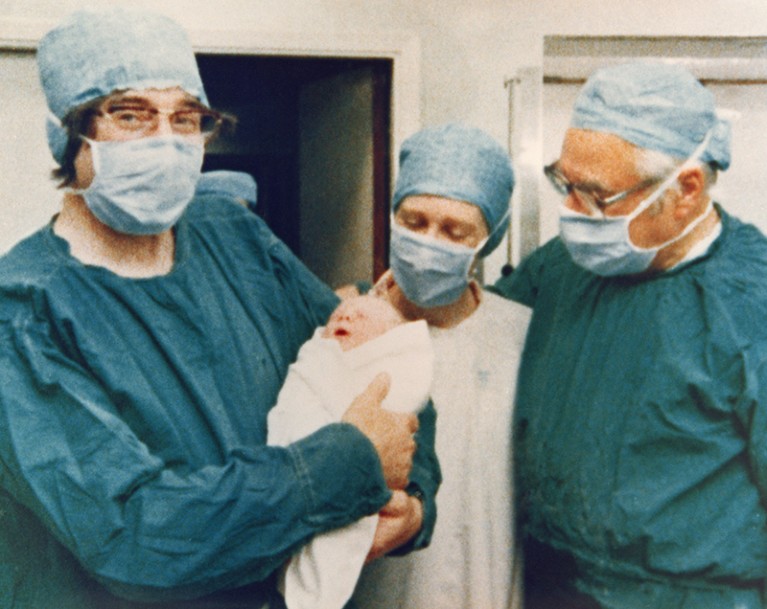
A human egg is fertilized in vitro.Credit: CC Studio/SPL
IVF: 6 Million Babies Later Science Museum, London 5 July 2018 to November 2018
By 2100, in vitro fertilization (IVF) might account for 3.5% of the global population — some 400 million people. It has already produced an estimated 6 million babies. Little wonder, then, that we tend to forget how remarkable IVF is, or how controversial it was 40 years ago, when researchers used the technique to conceive Louise Brown, the world’s first ‘test-tube’ baby.
London’s Science Museum celebrates Brown’s 40th birthday with an exhibition on the history and science of the procedure. Visitors to IVF: 6 Million Babies Later travel from the frustrating early days of research, when failure seemed unrelenting and funding unavailable, to today’s drive to improve global access to the technique.
The British researchers who blazed the trail in the 1960s loom large here. Among them were embryologist Robert Edwards (the first person to artificially fertilize human eggs in the laboratory), technician Jean Purdy and gynaecologist Patrick Steptoe. Purdy’s inclusion is key: not only did she nurture the embryo that would become Brown, but she was also the first to describe the early human blastocyst’s formation. Yet she is often omitted from official accounts of the feat.
Researchers familiar with disappointments in the lab will appreciate the group’s dogged pursuit of success despite seemingly insurmountable obstacles. In the decade leading up to Brown’s birth, the researchers attempted to collect eggs on 457 occasions from 282 women, transferred 112 embryos and initiated 5 pregnancies, but achieved no live births — until Brown. A scrawled note on display, in a lab notebook tallying some results from this work, records that “12 out of 16 had some abnormality!” Public scepticism was widespread, too.

IVF pioneers Robert Edwards (left), Jean Purdy (centre) and Patrick Steptoe with Louise Brown, the first baby born as a result of the technique.Credit: Hulton Archive/Getty
But persistence paid off. Louise Brown was a healthy baby, and she now has her own children. Her family became instant celebrities. The press was in such a frenzy to cover the story that reporters posed as cleaners to sneak into the hospital ward, and called in a fake bomb threat to force an evacuation.
But the exhibition really shines in showcasing the experiences of people who are currently undergoing fertility treatment. One display consists simply of the 19 needles, medicine vials and other equipment required for a typical IVF cycle. It is stunning. That anyone is willing to undergo the hormones, injections and price tag of about £5,000 (US$6,500) per cycle is a testament to the drive felt by so many to have children.
Recordings from three people who have experienced the process are telling. Worse than the needles and the hormones, says one woman, is the agonizing two-week wait between treatment and pregnancy test. She describes beating the odds (she was told her chances of conceiving were 1 in 125,000), only to spend most of her pregnancy fearful of miscarriage. (All was ultimately well: she has a daughter.)
Another woman talks about the devastation of undergoing the procedure without a happy outcome. After six cycles, she says, she and her partner were spent — emotionally, physically and financially. “We just felt completely lost and alone,” she says.
This small exhibition misses a chance to extrapolate from early concerns about IVF (which are largely dismissed, bar a cursory mention of how early pioneers were likened to Victor Frankenstein) to today’s debates over technologies such as mitochondrial-replacement therapy or genome editing. Both raise ethical concerns about altering embryos in ways that can be passed down to future generations. In a brief video about the future of embryo research, sociologist Sarah Franklin of the University of Cambridge, UK, mentions that researchers are increasingly pushing up against boundaries set when the field was getting started. The video does not detail how or why.
That is an odd omission. Since Brown’s birth, assisted reproduction has continued to generate controversy. Concerns about human cloning and ‘designer babies’ regularly make the headlines. Less reported but still pressing is the debate over how long human embryos used for research should be allowed to develop, now that technological improvements could enable researchers to push past the current UK limit of 14 days. As science advances, there will be more pushing at those boundaries — and a greater need for a serious examination of why they were erected in the first place.

 Genome editing: That's the way the CRISPR crumbles
Genome editing: That's the way the CRISPR crumbles






